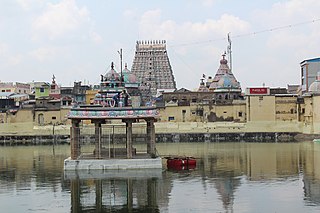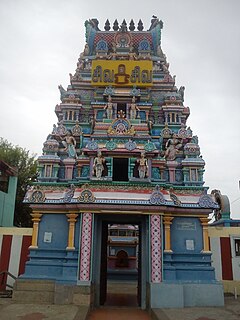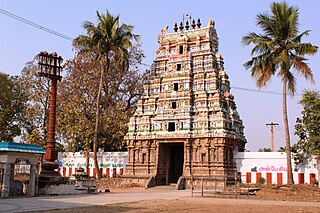
Nellaiappar Temple is a Hindu temple dedicated to the deity Shiva, located in Tirunelveli, a city in the South Indian state of Tamil Nadu. Shiva is worshipped as Nellaiappar represented by the lingam and his consort Parvati is depicted as Kanthimathi Amman. The temple is located on the northern banks of Thamirabarani River in Tirunelveli district. The presiding deity is revered in the 7th century Tamil Saiva canonical work, the Tevaram, written by Tamil saint poets known as the nayanmars and classified as Paadal Petra Sthalam.

Arulmigu Subramaniya Swamy Temple, Thiruparankundram is a Hindu temple and one of the Six Abodes of Murugan, located at Thiruparankundram,Tamilnadu, India. The temple is built in rock-cut architecture and believed to have been built by the Pandyas during the 6th century. According to the legend it is where Murugan slayed the demon Surapadman and married Deivayanai, the divine daughter of the king of heaven, Indra, and he is said to have worshipped Shiva here as Parangirinathar.

Adi Kumbeswarar Temple, Kumbakonam is a Hindu temple dedicated to the deity Shiva, located in the town of Kumbakonam in Thanjavur District Tamil Nadu, India. Shiva is worshiped as Adi Kumbeswarar, and is represented by the lingam. His consort Parvati is depicted as Mangalambigai Amman. The presiding deity is revered in the 7th century Tamil Saiva canonical work, the Tevaram, written by Tamil saint poets known as the Nayanmars and classified as Paadal Petra Sthalam.

Tiruppukkozhiyur is a Hindu temple dedicated to the deity Shiva, located in Avinasi, a panchayat town in Tiruppur district in the South Indian state of Tamil Nadu. Shiva is worshipped as Avinasiappar, and is represented by the lingam. His consort Parvati is depicted as Karunambigai. The presiding deity is revered in the 7th century Tamil Saiva canonical work, the Tevaram, written by Tamil saint poets known as the Nayanars and classified as Paadal Petra Sthalam.

Nageswaraswamy Temple, Kumbakonam is a Hindu temple dedicated to Shiva located in Kumbakonam in Thanjavur district, Tamil Nadu, India. The presiding deity is revered in the 7th century Tamil Saiva canonical work, the Tevaram, written by Tamil poet saints known as the nayanars and classified as Paadal Petra Sthalam. The temple is counted as the earliest of all Chola temples. Shiva in the guise of Nagaraja, the serpent king..

Garbharakshambigai Temple is a Hindu temple dedicated to Shiva located in Thirukarukavoor, Tamil Nadu, India. The temple is located 6 km (3.7 mi) east of Papanasam, 20 km (12 mi) south east of Kumbakonam, 10 km (6.2 mi) north of Saliyamangalam, 20 km (12 mi) north east of Thanjavur and on the southern bank of Vettar River. Constructed in the Dravidian style of architecture, the temple is believed to have been built during the Cholas period in the 7th century. Shiva is worshipped as Mullaivananathar and his consort Parvathi as Garbharakshambigai.

Vedaranyeswarar Temple is a Hindu temple dedicated to the god Shiva, located in the town of Vedaranyam in Tamil Nadu, India. Vedaranyeswarar is revered in the 7th century Tamil Shaiva canonical work, the Tevaram, written by Tamil saint poets known as the Nayanars and classified as Paadal Petra Sthalam. It is the only temple to have found mention in all the seven Thirumurais. The temple is famed for the legend between the saints Appar and Sambandar when the former sang to open the door while the latter sang to close the door.

Brahmapureeswarar Temple or Thiurkolili is a Hindu temple dedicated to Shiva located in Thirukkuvalai in Nagapattinam district of Tamil Nadu, India. Shiva is worshiped as Brahmapureeswarar, and is represented by the lingam and his consort Parvati is depicted as Vandamar Poonguzhali. The presiding deity is revered in the 7th century Tamil Saiva canonical work, the Tevaram, written by Tamil poet saints known as the nayanars and classified as Paadal Petra Sthalam.

Amirthakadeswarar Temple is a Hindu temple dedicated to the deity Shiva, located at Sakkottai in Tamil Nadu, India. The temple is dedicated to Shiva. Shiva is worshiped as Amirthakadeswarar, and is represented by the lingam. His consort Parvati is depicted as Amirthavalli Amman. The presiding deity is revered in the 7th century Tamil Saiva canonical work, the Tevaram, written by Tamil saint poets known as the Nayanmars and classified as Paadal Petra Sthalam.

Koneswarar Temple(Tamil: குடவாசல் கோணேசுவரர் கோயில்) is a Hindu temple in the town of Kudavasal in the Tiruvarur district of Tamil Nadu, India. The presiding deity is Shiva.

Padikasu Nathar Temple is a Hindu temple located at Azhagaputhur, a village in the Thanjavur district of Tamil Nadu, India. Shiva is worshiped as Padikasunathar, and is represented by the lingam. His consort Parvati is depicted as Soundaranayagi. The presiding deity is revered in the 7th century Tamil Saiva canonical work, the Tevaram, written by Tamil saint poets known as the nayanars and classified as Paadal Petra Sthalam. The 8th century Saiva saint poet Sundarar has sung praise about the temple in his works.

The Akshayapureeswarar Temple at Vilankulam in the Indian state of Tamil Nadu is a Hindu temple dedicated to Shiva and an art of the work achieved by Cholas in Tamil architecture Built in 1335 AD to 1365 AD by Parakrama Pandyan in Vilankulam, it turned 700 years old.

Tirunatyattankudi Rathnapureeswarar Temple is a Hindu temple located at Tirunattiyathankudi in Tiruvarur district, Tamil Nadu, India. The temple is dedicated to Shiva, as the moolavar presiding deity, in his manifestation as Rathnapureeswarar. He is also known as Manikkavannar. His consort, Parvati, is known as Mangalambikai.

Thirumuruganatheeswarar Temple in Thirumuruganpoondi, a panchayat town in Tiruppur district in the South Indian state of Tamil Nadu, is dedicated to the Hindu god Shiva. Constructed in the Dravidian style of architecture, the present structure of the temple is believed to have been built during the Kongu Cholas period in the 10th century. Shiva is worshipped as Thirumuruganatheeswarar and his consort Parvathi as Avudainayagi.

Bhaktajaneswarar Temple is a Hindu temple dedicated to the deity Shiva, located in Poondi, a village in Viluppuram district in the South Indian state of Tamil Nadu. Shiva is worshipped as Bhaktajaneswarar, and is represented by the lingam. His consort Parvati is depicted as Manonmani Amman. The temple is located on the Panruti - Kedilam road. The presiding deity is revered in the 7th century Tamil Saiva canonical work, the Tevaram, written by Tamil saint poets known as the nayanmars and classified as Paadal Petra Sthalam. The temple is closely associated with Sundarar, who is believed to have attained grace at this place.

Narthana Vallabeswarar Temple is a Hindu temple dedicated to the deity Shiva, located in Thirukoodalaiyathoor, a village in Cuddalore district in the South Indian state of Tamil Nadu. Shiva is worshipped as Narthana Vallabeswarar, and is represented by the lingam. His consort Parvati is depicted as Gnanasakthi and Parasakthi. The presiding deity is revered in the 7th century Tamil Saiva canonical work, the Tevaram, written by Tamil saint poets known as the Nayanars and classified as Paadal Petra Sthalam.
Masilamaninathar temple, Tharangambadi, also known as Alappur is a Siva temple in Tharangambadi in Mayiladuthurai district in Tamil Nadu (India). It is situated at a distance of 8 km from Tirukkadayur.

Sukreesvarar Temple is a Hindu temple dedicated to the deity Shiva, located at Sarkkar Periyapalayam in Tiruppur district in Tamil Nadu, India.
Dharmapureesvarar Temple is a Hindu temple dedicated to the deity Shiva, located at Vadakandam in Tiruvarur district, Tamil Nadu, India.
Vyagrapurisvarar Temple is a Hindu temple dedicated to the deity Shiva, located at Thaplampuliyur in the Tiruvarur district, Tamil Nadu, India.






















